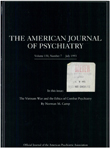Extrapyramidal symptoms due to dopamine-blocking agents in patients with AIDS encephalopathy
Abstract
OBJECTIVE: The authors attempted to determine whether patients with AIDS are more susceptible to neuroleptic side effects than other patients. METHOD: Retrospective chart review was used to assess the frequency and severity of extrapyramidal symptoms in patients with AIDS and psychotic patients without AIDS who had taken dopamine-blocking agents. The charts of 804 men younger than 50 years were reviewed, and patients were excluded if they had not taken dopamine blockers, had taken them for more than 1 month, had received concomitant antiparkinsonian agents, had focal brain lesions or histories of Parkinson's disease or meningitis, had used cocaine, amphetamines, or opiates within 1 month of admission, or, among the comparison group, had HIV risk factors. For the remaining 31 AIDS and 32 comparison patients, age, duration of dopamine blocker treatment, dose in chlorpromazine equivalents, and nature and severity of parkinsonian complications were recorded. RESULTS: The mean drug dose and body weight were significantly lower in the AIDS group. The likelihood of developing extrapyramidal symptoms was 2.4 times as high among the AIDS patients as among the comparison group. Such symptoms were developed by 50% of the AIDS patients who received less than 4 mg/kg of chlorpromazine equivalents per day and 78% of those who received more than 4 mg/kg per day. CONCLUSIONS: These preliminary results suggest that AIDS patients are more susceptible to extrapyramidal symptoms than psychotic patients without AIDS and that neuroleptics should be used cautiously and in lower doses for patients with AIDS.
Access content
To read the fulltext, please use one of the options below to sign in or purchase access.- Personal login
- Institutional Login
- Sign in via OpenAthens
- Register for access
-
Please login/register if you wish to pair your device and check access availability.
Not a subscriber?
PsychiatryOnline subscription options offer access to the DSM-5 library, books, journals, CME, and patient resources. This all-in-one virtual library provides psychiatrists and mental health professionals with key resources for diagnosis, treatment, research, and professional development.
Need more help? PsychiatryOnline Customer Service may be reached by emailing [email protected] or by calling 800-368-5777 (in the U.S.) or 703-907-7322 (outside the U.S.).



